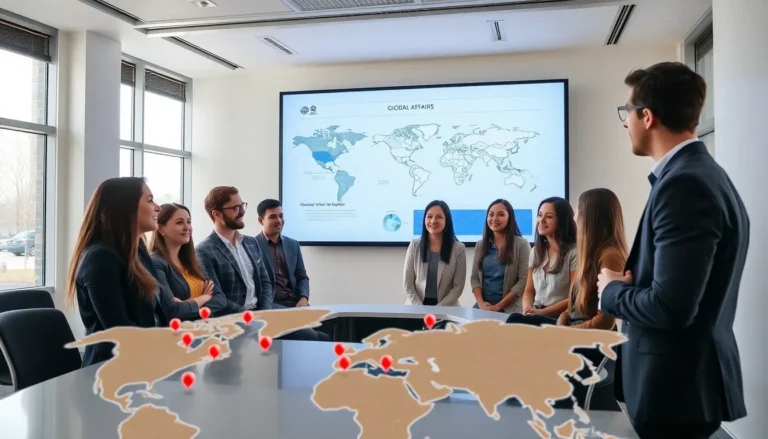Imagine having a language tutor available 24/7, one that doesn’t judge your accent or grammar mistakes. Well, that’s exactly what ChatGPT offers. In this fast-paced digital era, leveraging artificial intelligence for language learning isn’t just a gimmick, it’s a game changer. This article explores how ChatGPT can aid in mastering a new language, making the entire process entertaining and effective. Buckle up, because soon you’ll be chatting away in another tongue while impressing your friends, or at least avoiding some awkward phrases at your next international trip.
Table of Contents
ToggleUnderstanding ChatGPT and Its Capabilities

ChatGPT, a powerful AI model developed by OpenAI, acts like a highly intelligent conversation partner. Trained on a variety of texts, it can generate human-like responses in countless contexts. This versatility allows users to engage in linguistic exchanges that closely mimic real-life conversations.
Notably, ChatGPT understands and responds in multiple languages. This adaptability positions it as a valuable resource for language learners seeking to practice dialogue without the fear of making mistakes in front of others. Recognizing nuances in sentence structure and idiomatic expressions, ChatGPT serves not just as a source for information but also as an interactive learning aid.
Besides, it constantly learns from interactions, allowing it to improve its responses over time. This continuous growth means that it can stay relevant, providing up-to-date linguistic insights and knowledge tailored to individual learner needs.
How ChatGPT Facilitates Language Learning
ChatGPT creates a unique environment for language learners by offering immediate feedback and an expansive vocabulary bank. Imagine engaging in conversation where every wrong turn is met with gentle correction rather than criticism. This level of support makes the daunting journey of learning a new language feel approachable.
Also, learners can explore various topics without the pressure of a formal setting. From casual chit-chat about pop culture to in-depth discussions on complex subjects, ChatGPT allows learners to navigate their interests, all while practicing language skills. The AI’s responsiveness ensures that learners stay engaged, exploring topics that excite them.
Also, ChatGPT can simulate real-life scenarios, enabling learners to practice useful phrases they would use in everyday conversations. This kind of relevant practice not only boosts confidence but also prepares individuals for authentic interactions in their target language.
Tips for Effective Language Learning with ChatGPT
Using ChatGPT can be a breeze if approached strategically. Here are some practical tips:
Enhancing Language Skills through Conversation
Regular conversation practice is crucial. Engage with ChatGPT daily, discussing topics of choice. Keeping the sessions light and varied prevents fatigue while reinforcing vocabulary in context. This approach also helps learners grasp conversational rhythm, tone, and informal expressions.
Utilizing ChatGPT for Vocabulary Building
Words are the building blocks of language. ChatGPT can help learners expand their vocabulary effortlessly. Request definitions, synonyms, antonyms, or even create sentences using new words. This way, you can contextualize and retain unfamiliar vocabulary better, transforming daunting lists into fun learning sessions.
Practicing Grammar with ChatGPT
Grammar can often feel like a maze. But, using ChatGPT to clarify rules or correct sentences makes the journey smoother. Ask specific questions about grammar points, or check your sentence constructions. The AI’s ability to provide examples reinforces learning and aids in retention.
Creating Customized Learning Plans
One of the significant advantages of ChatGPT is its ability to craft personalized learning paths. Without the rigidity of traditional learning environments, users can define their goals and pace of study.
Start by assessing your language skill level and identifying specific objectives, whether it’s mastering tenses, expanding vocabulary, or becoming conversationally fluent. ChatGPT can help you lay out a structured plan, suggesting a daily or weekly learning schedule. Including interactive sessions, assignments, and assessments tailored to one’s learning style keeps the try engaging and effective.
To further enhance this personalized plan, learners can mix different types of practice. Alternating between speaking, writing, reading, and listening exercises creates a well-rounded experience. This adaptability of ChatGPT encourages continuous improvement, catering specifically to individual needs.
Challenges and Limitations of Using ChatGPT for Language Learning
While ChatGPT is a remarkable tool, it isn’t without its challenges. Reliance on AI for nuanced language intricacies can sometimes lead to misunderstandings. For example, subtle cultural references or humor might not always translate well, making context crucial for effective learning.
Also, learners might miss the human element that traditional language exchange partners bring to the table. Real-life interactions provide invaluable social cues and emotional context that AI cannot fully replicate. Feedback from a human can also often be more nuanced and relatable, whereas AI may lack some of these empathetic insights.
Finally, there’s the risk of over-relying on AI for language skills. A balanced approach is essential. Incorporating multiple resources, like conversation partners, actual language classes, and immersion experiences, ensures a comprehensive understanding and application of the language.
Success Stories: Real-Life Experiences with ChatGPT
Many individuals have found unique success in their language learning journeys with ChatGPT. From beginners taking their first steps into unfamiliar tongues to advanced learners refining nuances, experiences abound.
One user shared their journey learning French: “Initially, speaking felt daunting until I started chatting with ChatGPT. I practiced daily, and the AI’s feedback helped me build confidence. It felt like I had a supportive friend on my language journey.”
Another success story highlights a traveler preparing for a trip to Italy: “I used ChatGPT to learn useful phrases and cultural tidbits before my trip. The interactive practice made learning enjoyable and relevant. I was able to impress locals with my basic Italian.”
These real-life experiences underscore the potential of AI as a partner in language learning, making the process not just effective but also enjoyable.




